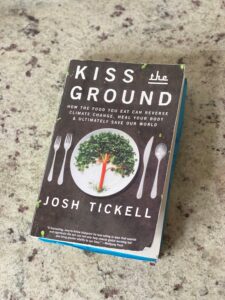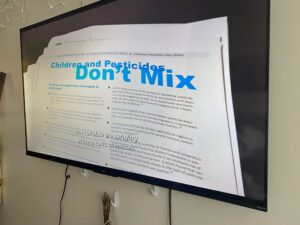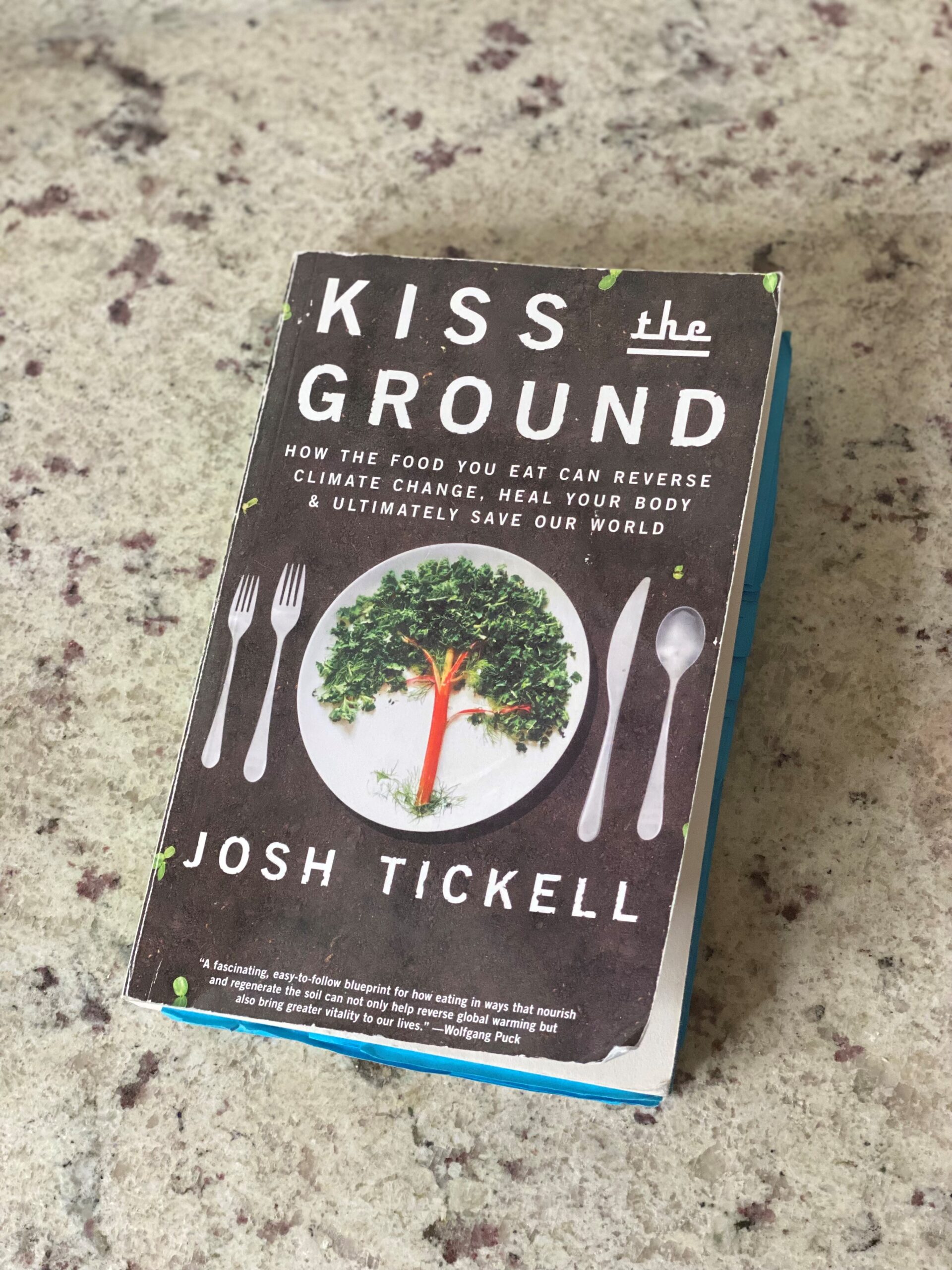To say ‘Kiss the Ground’ by Josh Tickell changed the way I look at the soil as well as the food I put in my body is an understatement. A revolution happened in my mind as I learned that the herbicides, pesticides, and fungicides (-cides) originated from Germany’s regrettable history (scientists Fritz Haber and Carl Bosch who were in cahoots with the Nazi party (50)) and that although the United States Department of Agriculture (USDA) has an organics certification program, they won’t test for chemicals in our food. I knew that the crops that eventually ended up on my dinner plate were doused in a chemical or two, but I had no idea to what extent.

Snapshot of the cover of ‘Kiss the Ground’
Looking at the big picture, ‘Kiss the Ground’ covers what is currently happening to our soil, how healthy soil practices work, and offers copious approaches for the average person to do their part to make an impact. I appreciate Tickell’s style of writing and his voice that keeps the reader engaged with humor and blunt honesty. He even got a chuckle out of me, something that doesn’t typically happen to me while reading nonfiction pieces.
From reading this paperback, I gathered that our food system, and thus, the earth, is in a crisis. I’ll spare you the detailed explanation to incentivize you to read the book for yourself (but in all transparency, I’d also butcher the details and send you off into the world misinformed). The most concise way I can say this is, the current farming practices are eroding our soil and causing desertification. Desertification is the man-made destruction of the underlying soil resource to such a degree that it can no longer support agriculture (91). Farming operations that aren’t soil conscious are tilling their dirt, showering their crops in -cides, and failing to rotate their crops which causes them to rely so heavily on -cides to produce a yield. Each year, for every American alive, three pounds of chemicals are applied to the crops we consume (70). And the kicker? The USDA, the very agency responsible for testing our food, does not test our foods for the majority of the harshest chemicals applied to our food (73). I’m APPALLED. I was even more surprised to learn that the spraying of our crops requires Tyvek suits and respirators (230). I’m not going to sit here and say that making these agricultural changes is easy, but I definitely agree with the author that these changes won’t be considered until there’s a high demand from the consumer (that’s us by the way).
If I’m not careful, each of my paragraphs could easily start with, “Did you know….?” And go on to list something that I believe the general public wouldn’t know. That’s how much information is offered in this reading. Let me just say this—did you know that biodiversity is a sign of healthy soil? Or that healthy soil holds significantly more water than unhealthy soil (the soil being sprayed and tilled)? Or even that healthy soils produce more yield as well as more nutrient-dense food? Okay, now that it’s out of my system let me explain. I’ll start with the fact that biodiversity in the soil is the norm, meaning that’s how it exists naturally, in nature (59). Modern farming practices (spraying the -cides) destroy organic matter that would otherwise nourish our crops. Have you heard of mycorrhizal fungi? She’s pretty important, look her up. Without this naturally existing organic matter, because of all the spraying, the crops are harder to grow, and that issue is also handled with nonother than more chemicals. Growing crops also require a large amount of water, and a lot of that water runs off because of the soil’s inability to soak it in. The amount of water is staggering, for example, California alone uses 38 billion gallons of water per day. If the soil was actually storing the water, they wouldn’t have to use (and waste) so much. The more soil organic matter (SOM) the more water can be stored in that soil. It’s estimated that before European settlement, the soil was storing four times as much water as it is today (100-101). Regenerative farming has the soil’s best interest in mind. These farmers have higher SOM and higher yields than their modern farming counterparts. Farmer Gabe Brown of Bismark, North Dakota is a shining example. His farm is GMO and -cides free and he is producing 25% more corn than the neighboring farms (251). He is also a poly cropper which opens more opportunities for income while benefiting the soil. Because of this, he’s not forced to rely on the government’s crop insurance to keep his function afloat.
The last chapter titled, ‘The Regenerative Revolution’ spans 26 pages and is dedicated to listing ideas on how the average American can contribute to the regenerative wave that will save the soil, the food, and eventually, us. You’d be surprised to see all the possibilities, and for the bulk of them, you don’t even have to be a grower of any kind. One of my personal favorites that I plan to implement into my lifestyle is buying my food at farmer’s markets. There you have the opportunity to meet the very people growing your food and learn about their farming practices straight from the source. This chapter also mentioned going on a farm visit. Most farms welcome visitors and very few will turn away volunteer work. Who wouldn’t want to get their hands dirty one afternoon?? (Probably a lot of people, but I’m still signing up!) Finally, a long-term goal of mine is to eat with the seasons. I want to be cognizant of what types of fruits are typically grown near me each season and stick to those. After all, consumer demand is what will get the shift to regenerative farming practices started. The lifestyle changes seem small, but I’m determined to do my part.
In short, I think this book is astounding. I’m recommending it to my circle and sharing what I’ve learned with anyone who will listen. This book is a great resource on its own and mentions another book, ‘The Omnivore’s Dilemma’ by Michael Pollan which is next on my reading list. I’ve also watched the movie version of ‘Kiss the Ground’ on Netflix which is supplementary to the text and easy to share with a friend if they’re not much of a reader. Tickell briefly mentions the controversial farmer Allan Savory in this book as well which prompted me to watch Savory’s popular TED Talk on YouTube. There’s so much to take away from this reading as it points you in different directions where you keep on learning. My recommendation? Read it! And then lend it to a friend. I’m blown away that these types of regenerative practices are in their budding stage. If you’ve made it this far in this posting, thanks for reading all the way through. Now go borrow a copy of ‘Kiss the Ground’!

‘Kiss the Ground’ movie playing on a TV
If you’d like to learn more about the organization and visit their website, click here. To read my last book review on ‘Rubbish!’ posting, click here.
